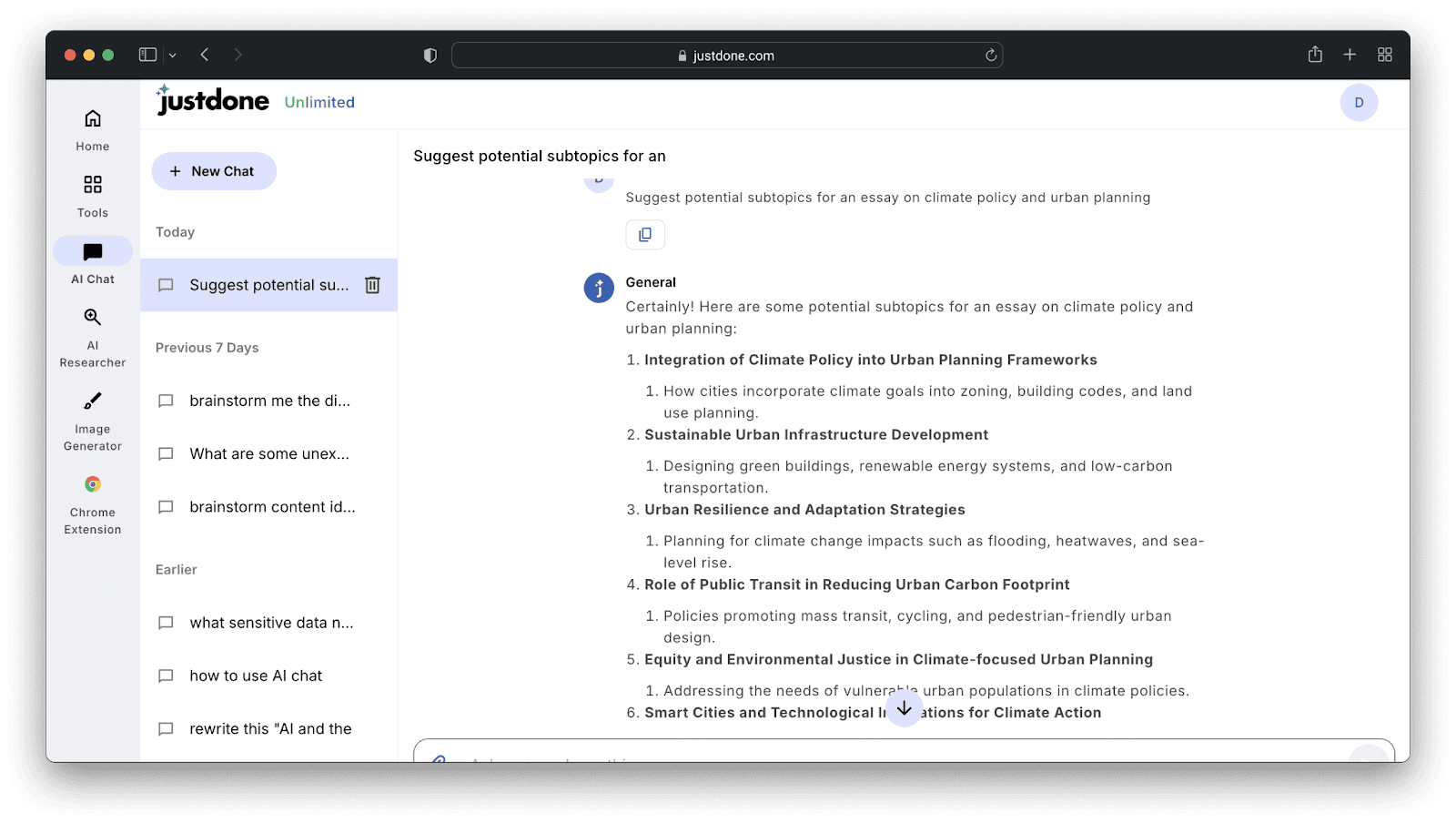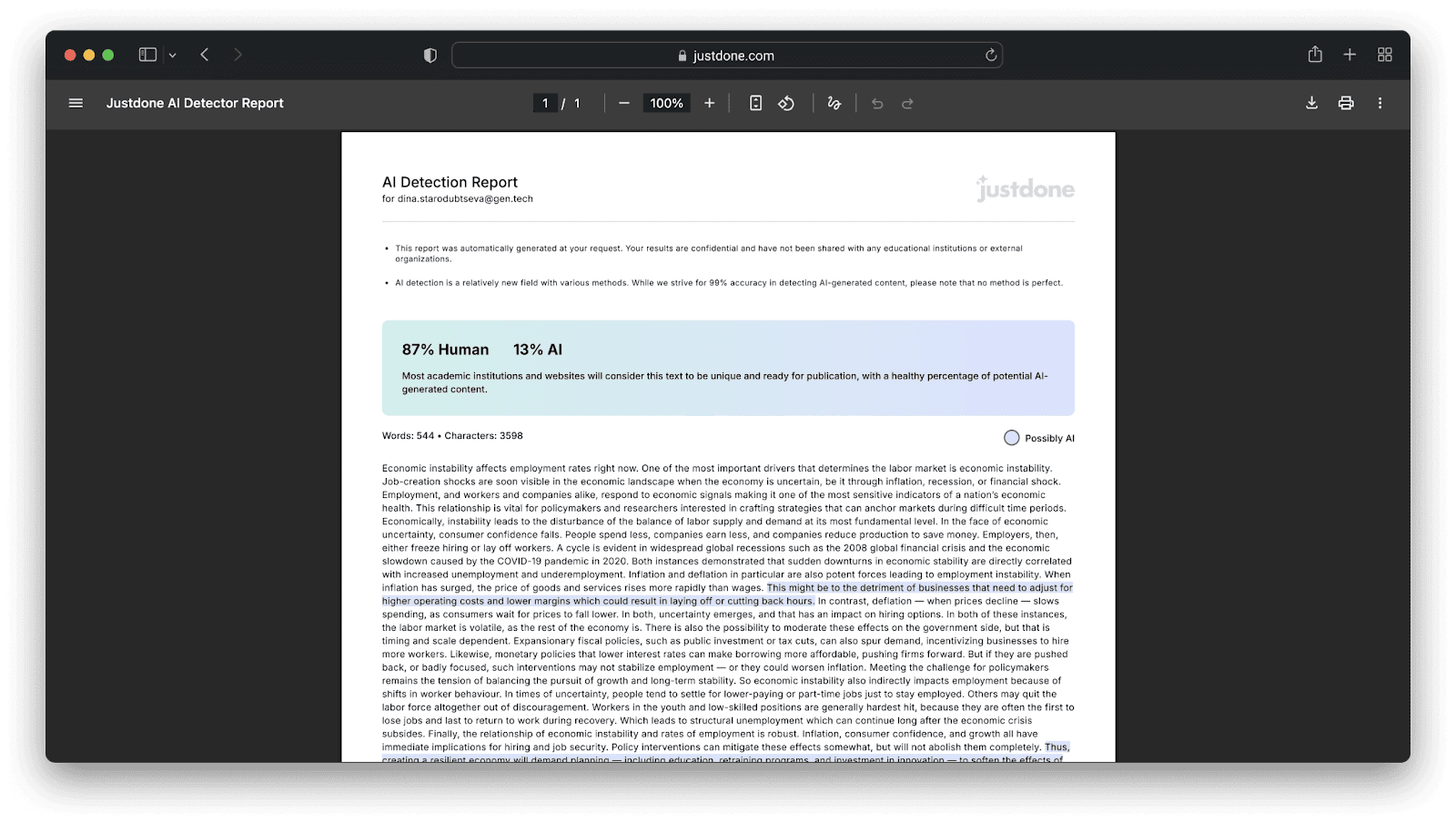AI tools have become inseparable from how students research, write, and study. But the challenge is that universities haven’t yet caught up. Policies differ across institutions: some allow AI for brainstorming, others forbid AI-assisted writing altogether. As a result, students face uncertainty, even fear, about what “responsible AI use” really means.
So how can you ensure your AI-assisted essay meets academic integrity standards? The answer lies in not avoiding AI, but rather using it transparently and ethically.
This guide breaks down clear, practical steps you can take to align your workflow with academic expectations. Also, you’ll learn how tools like JustDone’s AI Detector and Plagiarism Checker can help you stay confident in your work.
Academic integrity in the AI era
A recent Guardian investigation reports that thousands of university students in the UK have been caught misusing ChatGPT and other AI tools in the past few years. The rise of AI-assisted cheating has quickly become one of the most urgent challenges for modern academia.
Academic integrity is about honesty, fairness, and accountability in learning. Using AI doesn’t automatically violate those values, but how you use it determines whether your work remains ethical.
According to recent AI policies at major universities (Oxford, MIT, Cambridge, Stanford, and others), most institutions draw the line here:
- AI as a support tool is allowed for brainstorming, organizing, summarizing, and editing.
- AI as a content author is not allowed to generate entire essays, analyses, or arguments without disclosure or supervision.
Your responsibility as a student is to make sure AI assists your learning, but not replaces it. Think of AI as an assistant helping you clarify ideas, not as a ghostwriter.
Be transparent about how AI supports your work
One of the strongest indicators of integrity is transparency. If your institution’s policy allows it, acknowledge your use of AI tools in a footnote, appendix, or methodology section.
For example, you can include in the Bibliography section:
“AI-assisted writing tools were used to improve clarity and structure, but all arguments and interpretations are the author’s own.”
Transparency builds trust and prevents misunderstandings between students and faculty.
Even if disclosure isn’t required, documenting how AI contributed to your process (which tools you used and for what purpose) demonstrates your credibility.
Smart vs. Risky AI Use: Knowing the Difference
AI tools should enhance your cognitive process, not replace it. Below are examples of ethical and unethical uses of AI in academic writing:
Ethical AI Use | Unethical AI Use |
| Generating research questions or brainstorming ideas | Submitting an AI-written essay as your own |
| Summarizing complex readings to aid comprehension | Using AI to paraphrase sources without citation |
| Improving grammar, structure, or clarity | Replacing your critical analysis with AI-generated arguments |
| Checking for originality and citation accuracy | Editing AI text just enough to pass as human |
The difference is intellectual ownership. If your essay reflects your understanding, critical thought, and interpretation, even if you used AI tools, you’ve met academic integrity standards.
Integrate AI at the right stages of the writing process
AI can support multiple stages of academic writing if used purposefully. Here is the list of the most popular ways to use AI.
Idea generation and brainstorming
Use AI to refine your topic ideas, explore potential research gaps, or generate outlines.
Prompt examples you can use with AI chat:
- “Suggest potential subtopics for an essay on climate policy and urban planning.”

- “Summarize three competing theories on media ethics.”
This way, you can pick a direction AI gives, but you’re still responsible for validating sources and further academic relevance.
AI assistant for drafting and structuring text
AI can help you organize your essay logically. Ask it to:
- Suggest section headings and transitions.
- Review coherence between thesis and supporting arguments.
Then revise manually, because your outline should serve your ideas, not AI’s.
Clarity and language improvement
AI tools can enhance readability and polish language. For example, “Economic instability directly influences employment rates” is clearer than “It can be seen that economic instability affects employment rates.”
If you need one-style writing that sounds authentic and consistent, use AI humanizer. It can polish the tone and keep your originality. But remember: over-polishing can erase your voice. Use AI suggestions selectively, re-humanize if you need, and edit manually the final draft.
Here’s how AI humanizer can improve the robotic tone of your essay:

Revision and feedback
Before submission, AI tools can help you identify unclear sections, grammar issues, or unintentional repetition. Tools like JustDone’s AI Detector can also help you understand which parts of your text might resemble AI writing. Your goal is not to hide it, but to check that your essay still reflects your own voice and phrasing. Check the reports from the tools necessarily and work with the sections that are flagged, no matter who wrote them - you or AI.

Prevent plagiarism through AI verification
Even with good intentions, students can unintentionally reproduce text too closely to their sources, especially when paraphrasing academic material.
To ensure originality, do the following:
- Always keep track of your sources while researching
- Paraphrase thoughtfully, not mechanically
- Cross-check your essay with a plagiarism checker before submission
Advanced plagiarism checkers like Turnitin or JustDone help identify overlap between your work and published research. But while Turnitin is usually available only through school or university accounts, JustDone is open to everyone ( for students and outside academia), so you can check your text, fix citations, and rephrase when needed. With tools like these, it’s easier to keep your work honest and transparent.
Double-check citations and references generated by AI
One of the most common academic issues today is fake citations produced by AI tools. They may look real, with author names and journal titles, but lead nowhere.
Always verify references using databases like:
- Google Scholar
- JSTOR
- Semantic Scholar
- Your university’s library portal
AI can help format and organize references, but the accuracy of each citation remains your responsibility. Before submission, cross-check every reference and confirm it exists.
How to prove your work is not AI
Professors now routinely ask students to explain their essays in person or via email, especially when the work seems too polished. So, what to do if falsely accused of using Al? If you can explain your main arguments and conclusions in your own words, discuss your methodology, and reference your sources, nobody will flag your work.
Don’t be afraid to show how AI supported your process. The main idea is to describe the process, demonstrate drafts, and the doc’s history. This will show that you are the real author.
If you can confidently walk through your work, you’ve proven authorship and understanding. These are key pillars of integrity.
Know AI limits and how to build AI literacy
It is not enough just to generate work with a simple prompt. You need to understand how it works. This means recognizing its limitations:
- AI can’t assess truth or accuracy. It can only suggest the results, but you are responsible for the final verdict
- It can reproduce bias, false positives, and false negatives
- It can oversimplify nuanced arguments
Building AI literacy helps you engage critically rather than depend passively. For instance, if you use JustDone, it will encourage a responsible mindset. JustDone’s AI detector, humanizer, and plagiarism checker do not replace thinking, but help students analyze and verify what they’re working with.
Use AI tools that promote transparency and learning
Not all AI platforms serve academic integrity equally. Some are built to mask AI writing; others, like JustDone, are designed to enhance ethical use. For students and researchers, responsible AI tools should provide transparent detection and feedback (not binary “AI/Human” labels). It’s good when AI includes plagiarism insights and citation verification. Also, make sure your assistant offers rewrites that preserve academic tone and intellectual ownership.
These features support learning outcomes, not shortcuts. They help students understand where AI may have influenced their text and how to revise responsibly.
Responsible AI use is the future of academic integrity
AI in education is here to stay. The real challenge is to learn how to use it responsibly. Academic integrity in 2025-2026 is no longer just about avoiding plagiarism; it’s about transparency, authorship, and digital ethics. By integrating tools like JustDone’s AI Detector and Plagiarism Checker, you can ensure your essays remain authentic and aligned with institutional standards. So, remember three things:
- AI should enhance, not replace, your academic effort.
- Verification builds trust and protects your reputation.
- Transparency and self-reflection are the new benchmarks of integrity.
When used responsibly, AI only strengthens your learning and writing processes.